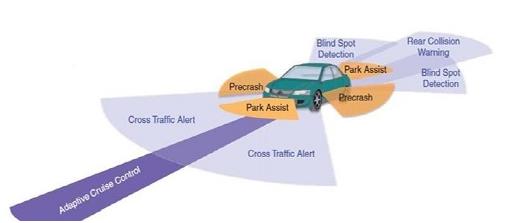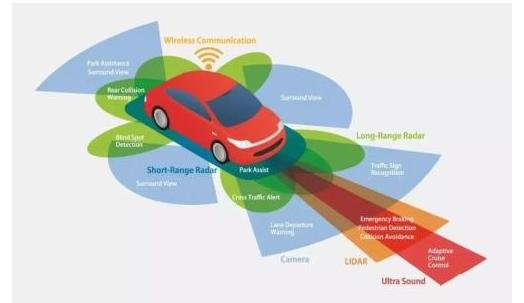When millimeter waves are applied in several ways, they get very hot. One of the applications that is gaining attention is millimeter wave radar circuit board technology. In this article, we will discuss millimeter wave radar printed circuit boards from two aspects. 1. Frequency Bands Division and Development Trend Analysis of Vehicle Millimeter Wave Radar PCBs. 2. Here are some application scenarios for millimeter wave radar circuit boards.

1. Frequency division of millimeter wave radar circuit boards for automobiles
(1) Introduction of frequency bands
From a frequency band perspective, automotive millimeter wave radar circuit boards have two common frequency bands.
a. 24 GHz, currently widely used in automotive blind spot monitoring and lane change assistance. Radar is attached to the rear bumper of the vehicle and is used to monitor whether there are vehicles in the lanes on either side of the rear of the vehicle and whether the lanes can be changed. This frequency band also has its drawbacks. One is that the frequency is relatively low, and the other is that the bandwidth (bandwidth) is relatively narrow, only 250MHz.
b. At 77 GHz, the frequency of this band is relatively high, and the internationally accepted bandwidth reaches 800 MHz. The performance of the radar in this frequency band would be superior to that of the 24 GHz radar, so it is mainly used to assemble on the front bumper of a vehicle to detect the distance and speed from the vehicle in front. It achieves active safety like vehicles ahead, emergency braking and automatic tracking.
At the process level, millimeter wave radar circuit boards currently have two main processes. One is SiGe and the other is CMOS. The advantage of SiGe is that the traditional semiconductor technology is very mature and the mass production of 77 GHz SiGe wafers has been achieved. The advantage of CMOS is its high degree of integration. In the future, the baseband and the radio frequencies can be centralized in a single SoC, which is technically very good. Regarding shipping, SiGe is still relatively important at the moment, as SiGe performs better than CMOS under high power condition. These two technologies currently coexist and will continue to coexist for some time to come.
(2) Advantages of millimeter wave radar map
Among the many on-board sensors, each sensor has its own unique characteristics and application scenarios, so there must be a solution for the fusion of multiple sensors in the future. Motor vehicle safety is a prerequisite for any development. Various sensors work together to monitor the vehicle environment with high and low delays. Millimeter wave radar circuit boards have reliable performance (such as handling severe weather conditions) and "all weather, all weather" functionality. “It has become one of the indispensable sensors for automotive ADAS.
(3) Trends in the degree of automation of motor transport
In addition to the different sensors, good or bad, there is another very important question. In other words, which is better in the two frequency bands 24GHz and 77GHz. Since the detection distance of the 24 GHz radar sensor is relatively short, around 50m, it is mainly used for blind spot monitoring (BSD) and lane change assistance (LCA). The 77 GHz radar sensor has a longer detection range, from 160 m to 230 m. Compared to 24 GHz, the 77 GHz radar sensor has a higher frequency, shorter wavelength and wider system bandwidth, which improves the measurement and accuracy of distance and speed. Mainly used for automatic emergency braking (AEB) and automotive adaptive cruise control (ACC) and forward. Collision warning (FCW) etc.

(4) Trends in on-board radar sensors in the 24 GHz frequency band and the 77 GHz frequency band
Today's markets need affordable products that can better solve problems and even in complex scenarios. Therefore, in the future, due to cost, performance, supply chain and other issues, the distribution positions of 77 GHz radar and 24 GHz radar will be completely different. It performs different functions in the vehicle. 77GHz not only replaces 24GHz, it coexists for a long time.
2. Millimeter wave radar circuit board application scenarios
(1) Smart office
At the critical moment of epidemic prevention, camera AI technology helps reduce direct or indirect contact in daily operations. At the same time, the adoption of AI technology has also improved the office experience and use experience, but does the large-scale use of cameras also bring relatively large hidden dangers, a way to protect privacy? Especially in some private or semi-public spaces, such as employee offices and meeting rooms.
The advantage of millimeter wave radar circuit boards over cameras is that they do not reveal privacy. No lens design hinders the appearance. More importantly, the information from radar data is also completely anonymous. Comply with applicable privacy laws. It can also be applied to more office scenarios that are not suitable for camera deployment.
The millimeter wave radar PCB also has advantages in terms of privacy issues related to AI camera technology. Since the radar recognition process basically occurs on the local device side, the amount of data sent to the background cloud is very small, only the location, trajectory information and statistical processing information of the recognized person. Network bandwidth and resources of the entire cloud are very limited, and enterprises can significantly reduce system operating costs.
(2) Smart home
For furniture for the elderly, multiple perceptions are particularly important. It is important to confirm in real time whether the physiological test data such as breathing data, heart rate data, and sleep quality of the elderly at home are normal. In addition, the protection of personal privacy in today's smart homes is becoming more and more stringent, which is also a question of waiting for technological progress to fill the gap. Millimeter-wave radar products can determine the presence or absence of a person by measuring physiological respiration, regardless of light or privacy, and at the same time determine the physiological state of the elderly by measuring respiration and heart rate. .It is an indispensable function in some emergency alarms, effectively responding to the needs of home care for the elderly.
In addition, in traditional smart homes, the automatic shutdown of air conditioning, lighting, gas, and illegal intrusion are all handled by an alarm system that combines cameras and infrared sensors, but there are many problems in camera privacy and infrared accuracy. There is no problem with the accuracy and privacy of millimeter wave radar printed circuit board products. At the same time, the radar products are very economical and the signal output is convenient, which is conducive to interaction with the scene. Due to its transparency, the radar can be easily installed in household appliances and lamps and used to create complementary camera connections.